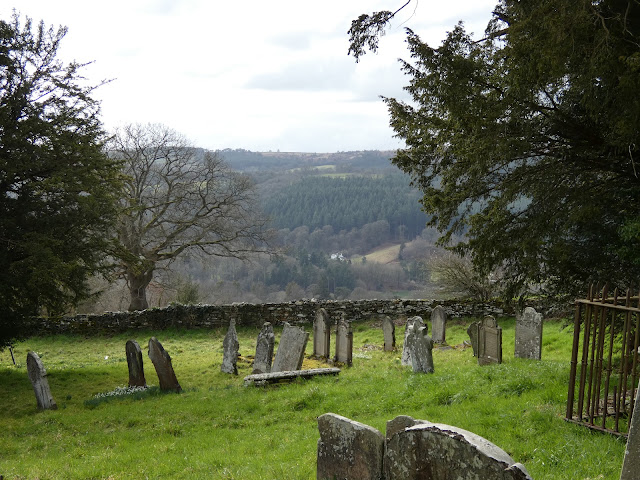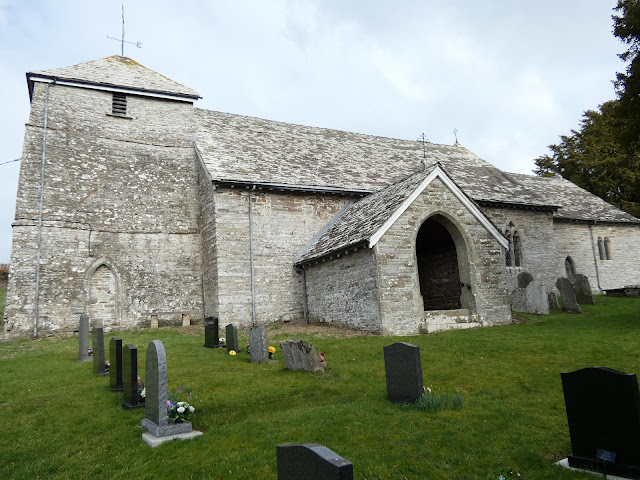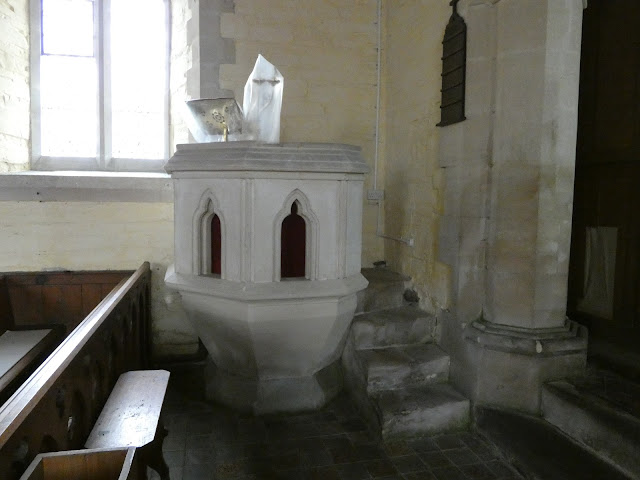
I needed a few hours out of the house yesterday, so with Keith settled, I set off to get paint for the guest bedroom (pale yellow) and then went on to Kington, as I wanted to see the church there. A post about St Mary's will follow. Inside the church was an alabaster memorial to Thomas and Ellen Vaughan, dating to the late 1600s. Their home, above and below, is a farmstead now, and dates to the 15th C. I have to say, beautiful snowdrops or not, I always get a bad feeling when I drive past this place. There's another, a Priory, near Goodrich Castle, which has the same effect. I used to drive past an abandoned cottage in a damp dingle a couple of miles from where we used to live. It gave me the heeby-jeebies, especially at night - so much so I refused to go to Brechfa after dark using that route. Many years on, when walking past I decided to take myself by the scruff of the neck and go and look inside. THAT was a mistake, as there was a truly horrible atmosphere, threatening and "black" is the best way of describing it, and believe me, I was GONE. So, I rather tend to listen to my gut feelings on places, even from a field or so distant! Lift your eyebrows all you want, but I was born with this - I'll call it "feyness" and it works in a number of different ways.


HERE is a link to a good photo of the church and the Court, and more info for you. Worth looking at.
Ellen the Terrible was so called because a killing which she perpetrated. The following extract from The Folklore of Radnorshire explains:
"During the unguarded moments of a festive carousel, two cousins-german (first cousins), namely, John Hir, or John the Tall, son of Philip Fychan, and David Fychan, quarrelled about the extent of their matrimonial inheritance, as parcelled out of the law of gavilkind (the custom of dividing a dead man's property equally among his sons), and fought with swords, in which combat, the latter was run through the body, and died on the spot. His death, however, did not pass unrevenged, for the sister of the slain, named Ellen Cethin, who resided at Hergest Croft, in the county of Herefordshire ,a woman of masculine strength, and intrepid spirit, hearing of the disastrous issue of this family dispute, and of the murder of her brother, repaired to the adjoining parish of Llanddewi (Ystradenni) on the day in which is had previously been fixed to hold a trial of archery. Disguising herself in men's clothes, she challenged the best archer in the field. This challenge was no sooner known than accepted by John Hir, who, entitled to the first shot, fixed his arrow in the centre of the target. Exulting in his success, and confident of the victory, he was followed by Ellen Cethin, whom, instead of pointing the head of the arrow in a line with the target, directed its flight against the body of her cousin-german John Hir, which is pierced, and went through his heart. " This apparently took place in 1430.
I loved reading this as apparently "a frequent visitor at the Court was Lewys Glyn Cothi, one of the greatest Welsh poets of the time. When Thomas died fighting in the Yorkist cause in1469, Lewys wrote a funeral elegy or marwnad which evoked his patron's fighting white-cuirassed like King Arthur at Camlan." Now, followers of my blog and the history of Ynyswen, our old home, will know that Lewys Glyn Cothi was also a frequent visitor there. Gosh, to have been a bi-lingual fly on the wall . . .
Thomas's body was returned for internment within the church of St Mary at Kington, close to his home. However, it was not long afterwards that apparently his spirit had not gone quietly to the grave. Now, we have a Kilvert link, and The Folklore of Radnorshire repeats what Kilvert's molecatcher told him:
"It was believed that the crimes he had committed would not let his spirit rest, for his ghost haunted the wood, and terrified innumerable people; it used to take special delight in waylaying women riding home from market at dusk, leaping up on their horses and sitting behind them. At last strong measures were taken to defeat the ghost. Twelve or thirteen ancient parsons assembled in the court of Hergest, and drew a circle, inside which they all stood with books and lighted candles, praying. The ghost was very resolute, and came among the parsons roaring like a bull. 'Why so fierce, Mr Vaughan?', asked one of the parsons mildly. 'Fierce I was a man, fiercer still as a devil', roared Vaughan, and all the candles were blown out except one, held by a very small, weak parson (also, says legend, named Vaughan). He hid the candle in his boot, and so kept it alight, all the time praying hard until at length the violent spirit was quelled. 'and brought down so small and humble that they shut him up in a snuff box.' The ghost made one humble petition - 'Do not bury me beneath water.' But the parson immediately had him enclosed in a stone box, and buried him under the bed of the brook, and Hergest thenceforth was at peace."
. . . and if that sounds at all familiar, it's because it was used at Disserth church, almost word for word, HERE'S my post about it from just over a year ago!

I presume the dog may well have been damaged during the Reformation, or perhaps when moving the tomb, but apparently the Hergest Black Dog (or the Black Dog of Hergest, which sounds better) was one of the manifestations of Black Vaughan and also had other connections with the family name . . .
Anyway, there will be some more posts from this outing - St Mary's Church, and a little gem of a church nearby at Huntingdon.
I marched myself round the lake in Llandod this morning when I went there to do some shopping, and cheered myself up with the purchase of two fruit trees from Tesco (£7 each or 2 for £12) - I got a Cox apple and a Victoria plum, they were very standard choices. Those now have their roots in water and tomorrow I will plant them. I also bought a Tesco boxed "Perfect for Pots" collection which has a Dahlia, some Freesias, Gladioli, and seeds for Cosmos, Calendula and Cornflowers. Not bad value. I have two biggish pots I've emptied and will plant them up with these tomorrow. I have some Dahlias I had planted last year so will even up the 2nd tub with a clump of those tubers.
Keith has gotten over our early start and bad night's sleep on Monday and is a bit more sprightly again. We have to make sure that the patches are replaced in good time, as we forgot the other night and it was like someone had pulled the plug out!

















































